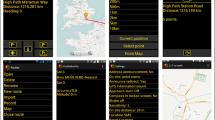Abstract
The accessibility of graphics and multimedia should be considered from at least two distinct perspectives. First, in terms of the provision of sufficient information for people with disabilities that limit access to specific elements of the content. Second, graphics and multimedia can be thought of as equivalent alternatives to text for those with cognitive disabilities. This chapter looks at issues in the delivery of equivalent information and the preservation of essential content so as to serve the largest possible audience.
Access this chapter
Tax calculation will be finalised at checkout
Purchases are for personal use only
Similar content being viewed by others
References
Adobe Systems Incorporated. Cairngorm. Retrieved February 1, 2007, from the World Wide Web: http://labs.adobe.com/wiki/index.php/Cairngorm
Apple, Incorporated. Introduction to Accessibility Programming Guidelines for Cocoa. Retrieved February 1, 2007, from the World Wide Web: http://developer.apple.com/documentation/Cocoa/Conceptual/Accessibility/index.html//apple_ref/doc/uid/10000118i
Duhl, J. (2003) The Business Impact of Rich Internet Applications. Retrieved February 1, 2007, from the World Wide Web: http://download.macromedia.com/pub/solutions/downloads/business/idc_impact_of_rias.pdf
Free Standards Group Accessibility workgroup. (2006, Dec 2). IAccessible2 API Documentation. Retrieved February 1, 2007, from the World Wide Web: http://accessibility.freestandards.org/a11yspecs/ia2/docs/html/
The GNOME Project. ATK–Accessibility Toolkit. Retrieved February 1, 2007, from the World Wide Web: http://developer.gnome.org/doc/API/2.0/atk/
Microsoft. Microsoft Active Accessibility Version 2.0. Retrieved February 1, 2007, from the World Wide Web: http://msdn.microsoft.com/library/default.asp?url=/library/en-us/msaa/msaastart_9w2t.asp
Microsoft. UI Automation Overview. Retrieved February 1, 2007, from the World Wide Web: http://msdn2.microsoft.com/en-us/library/65847654-9994-4a9e-b36d-2dd5d998770b.aspx
Regan, B. (2005, August) Best Practices for Accessible Flash Design. February 1, 2007, from the World Wide Web: http://www.adobe.com/resources/accessibility/best_practices/best_practices_acc_flash.pdf
Shea, D. and Holzschlag, M. E. (2005) The Zen of CSS Design: Visual Enlightenment for the Web. Peachpit Press, Berkley, CA.
Tufte, E. (2001) The Visual Display of Quantitative Information. Graphics Press, Chesire, CT.
Web Accessibility in Mind. Appropriate Use of Alternative Text. Retrieved February 1, 2007, from the World Wide Web: http://www.webaim.org/techniques/alttext/
World Wide Web Consortium. (1999, May 5). Web Content Accessibility Guidelines. Retrieved February 1, 2007, from the World Wide Web: http://www.w3.org/TR/WCAG10/wai-pageauth.html
Yahoo! Developer Network. Design Pattern Library. Retrieved February 1, 2007, from the World Wide Web: http://developer.yahoo.com/ypatterns/
Author information
Authors and Affiliations
Corresponding author
Editor information
Editors and Affiliations
Rights and permissions
Copyright information
© 2008 Springer-Verlag London Limited
About this chapter
Cite this chapter
Regan, B., Kirkpatrick, A. (2008). Multimedia and Graphics. In: Harper, S., Yesilada, Y. (eds) Web Accessibility. Human-Computer Interaction Series. Springer, London. https://doi.org/10.1007/978-1-84800-050-6_17
Download citation
DOI: https://doi.org/10.1007/978-1-84800-050-6_17
Publisher Name: Springer, London
Print ISBN: 978-1-84800-049-0
Online ISBN: 978-1-84800-050-6
eBook Packages: Computer ScienceComputer Science (R0)




